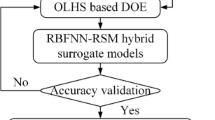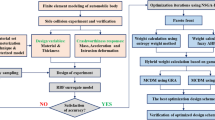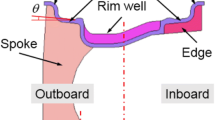Abstract
To improve the lightweight of the automotive body, the structure–connection–performance integration optimisation design was conducted for the multi-material body skeleton. The equivalent simplified joint model was established for dissimilar material self-piercing riveting (SPR) joints to address the problem that the finite element model of multi-material body skeleton was difficult to calculate due to the excessive number of elements of SPR joints. The rivet set coding technique was proposed to overcome the technical bottleneck that the SPR joint connection parameters cannot be integrated into the body structure–performance collaborative optimisation. The integrated optimisation parametric model of the structure–connection–performance of the multi-material body skeleton was established by combining structural parameterisation and mesh deformation techniques. The multi-objective automatic iterative optimisation of the body skeleton was achieved by using the RBFNN-Kriging hybrid surrogate model and NSGA-II, and the Pareto front was mined using AHP-TOPSIS method. The results show that the performance of the optimised body structure is significantly improved and fully meets the design requirements. The mass of the body skeleton is 116.88 kg, which is 28.62 kg lighter than the same size benchmark body skeleton, and the weight reduction ratio is 19.67%. A front-end structure of the body skeleton was developed and subjected to high-speed impact test, which validates the accuracy of the simulation analysis.









































Similar content being viewed by others
References
Ang HQ (2021) An overview of self-piercing riveting process with focus on joint failures, corrosion issues and optimisation techniques. Chin J Mech Eng 34:25
Cavusoglu O, Bakirci A, Dinkci H, Yilmazoglu AG (2022) Triple joining of different sheets with self-pierce riveting method. Sci Technol Weld Join 27:579–585
Chen X, Ma FW, Wang DF, **e C (2014) Carbody structural lightweighting based on implicit parameterized model. Chin J Mech Eng 27:483–487
Chen Y, Liu GP, Zhang ZY, Hou SJ (2017) Integrated design technique for materials and structures of vehicle body under crash safety considerations. Struct Multidisc Optim 56:455–472
Cheng BQ, Chang RD, Yin QH, Li JC, Huang JL, Chen HH (2023) A PSR-AHP-GE model for evaluating environmental impacts of spoil disposal areas in high-speed railway engineering. J Clean Prod 388:11
Ciampaglia A, Santini A, Belingardi G (2021) Design and analysis of automotive lightweight materials suspension based on finite element analysis. Proc Inst Mech Eng Part C J Mech Eng Sci 235:1501–1511
Cui XT, Wang SX, Hu SJ (2008) A method for optimal design of automotive body assembly using multi-material construction. Mater Des 29:381–387
Deb K (1999) Multi-objective genetic algorithms: problem difficulties and construction of test problems. Evol Comput 7:205–230
Deb K, Pratap A, Agarwal S, Meyarivan T (2002) A fast and elitist multiobjective genetic algorithm: NSGA-II. IEEE Trans Evol Comput 6:182–197
Evgeniou T, Pontil M, Poggio T (2000) Regularization networks and support vector machines. Adv Comput Math 13:1–50
Fang HB, Horstemeyer MF (2006) Global response approximation with radial basis functions. Eng Optim 38:407–424
Fang H, Rais-Rohani M, Liu Z, Horstemeyer MF (2005) A comparative study of metamodeling methods for multiobjective crashworthiness optimization. Comput Struct 83:2121–2136
Golchi MM, Saraeian S, Heydari M (2019) A hybrid of firefly and improved particle swarm optimization algorithms for load balancing in cloud environments: performance evaluation. Comput Netw 162:15
Hanssen AG, Olovsson L, Porcaro R, Langseth M (2010) A large-scale finite element point-connector model for self-piercing rivet connections. Eur J Mech A Solids 29:484–495
Haque R (2018) Quality of self-piercing riveting (SPR) joints from cross-sectional perspective: a review. Arch Civ Mech Eng 18:83–93
Hirsch F, Muller S, Machens M, Staschko R, Fuchs N, Kastner M (2017) Simulation of self-piercing rivetting processes in fibre reinforced polymers: material modelling and parameter identification. J Mater Process Technol 241:164–177
Izanloo M, Khalkhali A (2022) Optimal design of automotive body B-pillar using simplified finite element model of body-in-prime combined with an optimization procedure. J Cent South Univ 29:3939–3955
Kam DH, Jeong TE, Kim J (2020) A quality study of a self-piercing riveted joint between vibration-dam** aluminum alloy and dissimilar materials. Appl Sci (Basel) 10:11
Karim MA, Jeong TE, Noh W, Park KY, Kam DH, Kim C, Nam DG, Jung H, Park YD (2020) Joint quality of self-piercing riveting (SPR) and mechanical behavior under the frictional effect of various rivet coatings. J Manuf Process 58:466–477
Kim C, Min KM, Choi H, Kim HJ, Lee MG (2021) Development of analytical strength estimator for self-piercing rivet joints through observation of finite element simulations. Int J Mech Sci 202:19
Lu RH, Gao WZ, Hu XL, Liu WH, Li YW, Liu XH (2018) Crushing analysis and crashworthiness optimization of tailor rolled tubes with variation of thickness and material properties. Int J Mech Sci 136:67–84
Mihaylova P, Baldanzini N, Pierini M (2015) Advanced sizing optimisation of concept vehicle structures. Int J Veh Des 67:1–25
Mohammadi H, Ahmad Z, Mazlan SA, Johari MAF, Siebert G, Petru M, Koloor SSR (2023) Lightweight glass fiber-reinforced polymer composite for automotive bumper applications: a review. Polymers 15:30
Mora AM, Merelo JJ, Laredo JLJ, Millan C, Torrecillas J (2009) Chac, A Moaco algorithm for computation of bi-criteria military unit path in the battlefield: presentation and first results. Int J Intell Syst 24:818–843
Park SW, Choi JN, Lee BC (2018) Multi-objective optimization of an automotive body component with fiber-reinforced composites. Struct Multidisc Optim 58:2203–2217
Salmani H, Khalkhali A, Ahmadi A (2022) Multi-objective optimization of vehicle floor panel with a laminated structure based on V-shape development model and taguchi-based grey relational analysis. Struct Multidisc Optim 65:23
Simpson TW, Peplinski JD, Koch PN, Allen JK (2001) Metamodels for computer-based engineering design: survey and recommendations. Eng Comput 17:129–150
Viana FAC, Haftka RT, Steffen V (2009) Multiple surrogates: how cross-validation errors can help us to obtain the best predictor. Struct Multidisc Optim 39:439–457
Wang DF, Cai KF (2018) Optimizing the static-dynamic performance of the body-in-white using a modified non-dominated sorting genetic algorithm coupled with grey relational analysis. Eng Optim 50:615–633
Wang DF, Li SH (2021) Collaborative optimization design of lightweight and crashworthiness of the front-end structures of automobile body using HW-GRA for Pareto mining. Proc Inst Mech Eng Part C J Mech Eng Sci 235:5201–5215
Wang DF, Li SH (2022a) Lightweight design of a body-in-white structure using a hybrid optimisation approach. Int J Veh Des 88:121–147
Wang DF, Li SH (2022b) Material selection decision-making method for multi-material lightweight automotive body driven by performance. Proc Inst Mech Eng Part L J Mater Des Appl 236:730–746
Wang S, Wang DF (2021) Crashworthiness-based multi-objective integrated optimization of electric vehicle chassis frame. Arch Civ Mech Eng 21:18
Wang DF, **e C (2020) Contribution analysis of the cab-in-white for lightweight optimization employing a hybrid multi-criteria decision-making method under static and dynamic performance. Eng Optim 52:1903–1922
Wang SP, Zhao DM, Yuan JZ, Li HJ, Gao Y (2019) Application Of NSGA-II algorithm for fault diagnosis in power system. Electr Power Syst Res 175:8
Wang DF, Kong DW, **e C, Li SH, Zong L (2022a) Study on the effect of rivet die parameters on joint quality of self-piercing riveting employed 3D modeling and MCDM Method. Int J Adv Manuf Technol 119:8227–8241
Wang DF, Li SH, **e C (2022b) Crashworthiness optimisation and lightweight for front-end safety parts of automobile body using a hybrid optimisation method. Int J Crashworthiness 27:1193–1204
Wang J, Zhang YL, Cheng LX, Yang YP, Bi YB (2022c) Effect of riveting parameters on the forming quality of riveted lap joints with reduced countersunk head half-crown rivet. Int J Adv Manuf Technol 121:8083–8098
**ong F, Wang DF, Chen SM, Gao Q, Tian SD (2018a) Multi-objective lightweight and crashworthiness optimization for the side structure of an automobile body. Struct Multidisc Optim 58:1823–1843
**ong F, Wang DF, Ma ZD, Chen SM, Lv TT, Lu F (2018b) Structure–material integrated multi-objective lightweight design of the front end structure of automobile body. Struct Multidisc Optim 57:829–847
**ong F, Zou XH, Zhang ZG, Shi XH (2020) A systematic approach for multi-objective lightweight and stiffness optimization of a car body. Struct Multidisc Optim 62:3229–3248
Xue B, Zhang MJ, Browne WN (2013) Particle swarm optimization for feature selection in classification: a multi-objective approach. IEEE Trans Cybern 43:1656–1671
Xue ZG, Wang XY, Xu CC, Chen ZM, Feng XH, Zhou QY, Liu JP, Li LX (2023) Equivalent characterization of pre-strained material properties and mechanical behavior prediction of steel/aluminum self-piercing riveted. Thin Walled Struct 182:18
Zhang JF, Wang LM, Wang T, Sun HM, Zou XJ, Yuan LK (2022) Frontal crashworthiness optimization for a light-duty vehicle based on a multi-objective reliability method. Int J Crashworthiness. https://doi.org/10.1080/13588265.2022.2109347
Zhao H, Han L, Liu YP, Liu XP (2021) Modelling and interaction analysis of the self-pierce riveting process using regression analysis and FE. Int J Adv Manuf Technol 113:159–176
Zhu P, Zhang Y, Chen GL (2009) Metamodel-based lightweight design of an automotive front-body structure using robust optimization. Proc Inst Mech Eng Part D J Automobile Eng 223:1133–1147
Acknowledgements
This work was supported by the National Natural Science Foundation of China (51975244).
Author information
Authors and Affiliations
Corresponding author
Ethics declarations
Competing interests
The authors declare that they have no known competing financial interests or personal relationships that could have appeared to influence the work reported in this paper.
Replication of results
The methodology, supplementary materials, references and parameters provided in this paper constitute all necessary information required to replicate the generated results.
Additional information
Responsible Editor: Erdem Acar
Publisher's Note
Springer Nature remains neutral with regard to jurisdictional claims in published maps and institutional affiliations.
Supplementary Information
Below is the link to the electronic supplementary material.
Rights and permissions
Springer Nature or its licensor (e.g. a society or other partner) holds exclusive rights to this article under a publishing agreement with the author(s) or other rightsholder(s); author self-archiving of the accepted manuscript version of this article is solely governed by the terms of such publishing agreement and applicable law.
About this article
Cite this article
Li, S., Wang, D., Wang, S. et al. Structure–connection–performance integration lightweight optimisation design of multi-material automotive body skeleton. Struct Multidisc Optim 66, 198 (2023). https://doi.org/10.1007/s00158-023-03656-z
Received:
Revised:
Accepted:
Published:
DOI: https://doi.org/10.1007/s00158-023-03656-z




